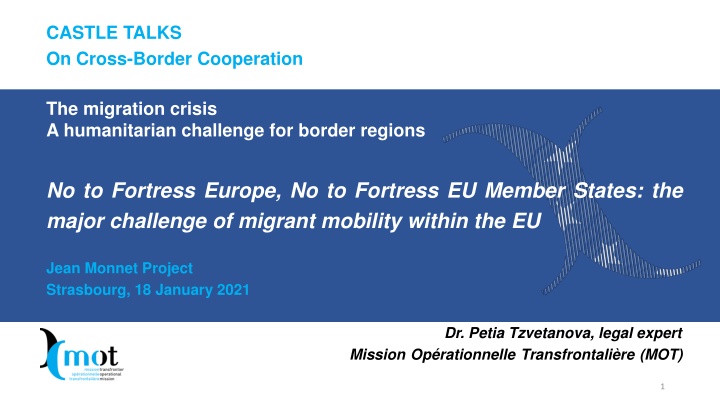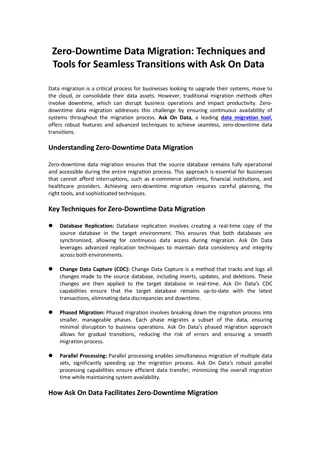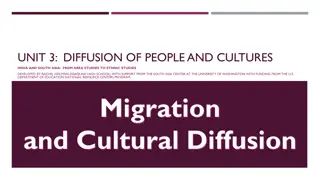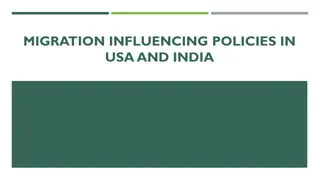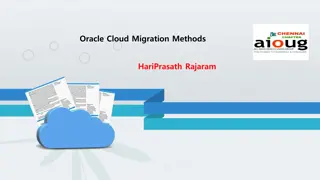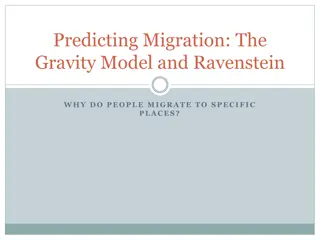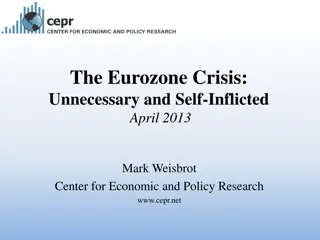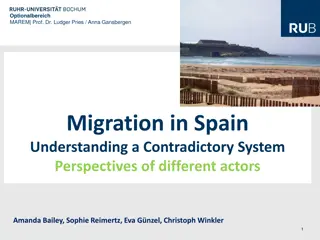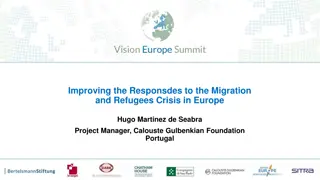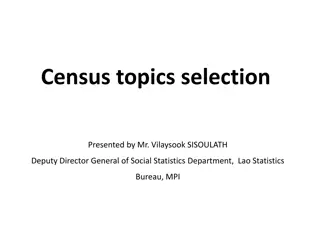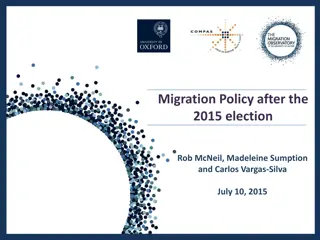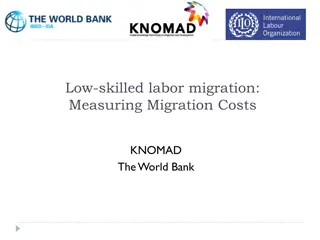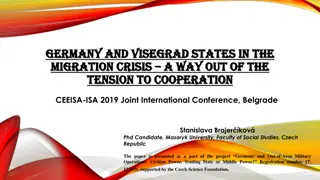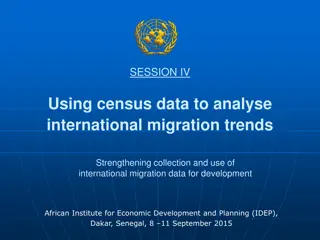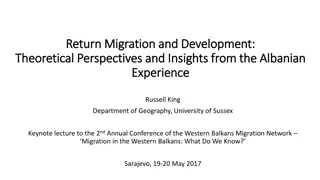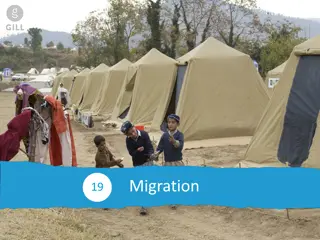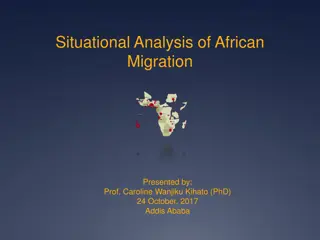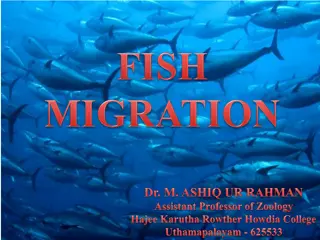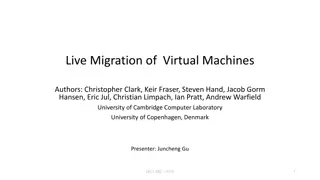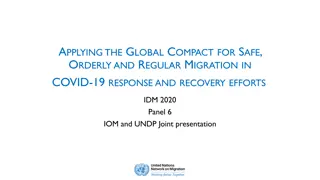Challenges and Measures in EU Migration Crisis Management
The discussion covers the humanitarian challenges of the migration crisis, emphasizing the need for a collaborative approach within the EU to address migrant mobility effectively. It analyzes common EU measures to control migrant flows, outlines the processing of migrant arrivals both at the EU and national levels, and highlights the consequences of border closures on migrants and EU policies.
Download Presentation

Please find below an Image/Link to download the presentation.
The content on the website is provided AS IS for your information and personal use only. It may not be sold, licensed, or shared on other websites without obtaining consent from the author.If you encounter any issues during the download, it is possible that the publisher has removed the file from their server.
You are allowed to download the files provided on this website for personal or commercial use, subject to the condition that they are used lawfully. All files are the property of their respective owners.
The content on the website is provided AS IS for your information and personal use only. It may not be sold, licensed, or shared on other websites without obtaining consent from the author.
E N D
Presentation Transcript
CASTLE TALKS On Cross-Border Cooperation The migration crisis A humanitarian challenge for border regions No to Fortress Europe, No to Fortress EU Member States: the major challenge of migrant mobility within the EU Jean Monnet Project Strasbourg, 18 January 2021 Dr. Petia Tzvetanova, legal expert Mission Op rationnelle Transfrontali re (MOT) 1
The migration crisis from a comparative perspective: How UE and member States deal with the migration crisis? 1) Common EU measures in the direction of closing the migrants' roads and borders 2) The processing of migrant arrivals: Soft and general UE framework: The Common European Asylum System (CEAS) setting out common standards to ensure that asylum seekers are treated equally and aiming to guarantee the main principles of the 28 July 1951 Geneva Convention on the protection of Refugees 3) The processing of migrant arrivals: Mainly national policies 2
1) Common EU measures in the direction of closing the migrants' roads and borders -October 2015: measures for the closure of the Balkans road; -March 2016 EU-Turkey declaration for the closure of the Eastern Mediterranean road (based on the assumption that Turkey is a safe third country in the sense of the Asylum Procedures Directive 2013); -February 2017 Malta s declaration for the closure of the Central Mediterranean road; 3
Consequences: 1) emergence of migrant camps at borders with terrible living conditions => humanitarian crisis 2) non-application of the European principle of non-refoulement as migrants remain in outside EU territories 4
2) The processing of migrant arrivals at EU level The Common European Asylum System (CEAS): 1) Asylum Procedures Directive 2013/32/EU aims at fairer, quicker and better quality asylum decisions, introduces procedural guarantees in the examination of applications 2) Reception Conditions Directive 2013/33/EU ensures that there are humane material reception conditions (such as housing) for asylum seekers across the EU and that the fundamental rights of the concerned persons are fully respected 3) Qualification Directive 2011/95/EU clarifies the grounds for granting international protection in order to improve the access to rights and integration measures for beneficiaries of international protection 5
The Common European Asylum System (CEAS): 4) Dublin III Regulation (EU) N 604/2013 sets the criteria of establishing the State responsible for examining the application for each migrant arriving on European territory with a request for international protection, and clarifies the rules governing the relations between States 5) EURODAC Regulation (EU) N 603/2013 regulates access to the EU database of the fingerprints of asylum seekers; the access is allowed under strictly limited circumstances only in order to prevent, detect or investigate the most serious crimes, such as murder, and terrorism. 6
In 2001, the Temporary Protection Directive 2001/55/EC allowed for a common EU response to a mass influx of displaced persons unable to return to their country of origin. It promotes a balance of efforts between EU countries in receiving people. The provisions within this Directive, based on solidarity between EU States, are the only common responses foreseen. They have not been triggered so far (in spite of current events) Outside this framework, no distribution of efforts with regard to the processing of migrant arrivals 7
3) The processing of migrant arrivals: It's all based on national policies No harmonization between member States Internal procedure for granting refugee status and then on this basis national residency, working and travel permits needed No recognition of the other states national papers 8
In France Since 2016 there are single counters for asylum seekers (guichets uniques pour demandeurs d asile GUDA) in each department (96), places where all national services are brought together. It is necessary to contact a SPADA (structure for the first reception of asylum seekers: structure du premier accueil des demandeurs d'asile) in order to receive an appointment for the GUDA. These association operators must manage a quota of appointments allocated by the department's single counter. The Prefecture receives the person who presents photos, indications of his or her itinerary and civil status. The Prefecture must register the request and takes the fingerprints on the so-called "Eurodac" terminal. The OFII (Office Fran ais de l'immigration et de l'int gration) receives the person being interviewed, offers him to accept an in-principle offer of assistance and may offer accommodation and an allowance. The OFII forwards this information to OFPRA (Office Fran ais de Protection des R fugi s et Apatrides). 9
Consequences: No EU mobility for both refugee status claimants and refugees who have been granted international protection by a State In case of a move, new procedure and new documents needed National permits still needed even in case of a European long-term card holder (Directive 2003/109/EC concerning the status of third- country nationals who are long-term residents) 10
Conclusion: The mobility of migrants within the EU is neither allowed nor intended No common migration crisis management, except for the Temporary Protection Directive 2001, since it has provided a common EU response to a mass influx of displaced persons (never been initiated at EU level) 11
Recommandation: For the needs of cross-border areas, the MOT is lobbying for the recognition of the status of cross-border workers of migrants to facilitate their mobility in these areas on the basis of the provisions of Art.5 of Directive 2003/109/EC Cross-border workers may also be subject to specific provisions of national law. 12
THANK YOU FOR YOUR ATTENTION More information: www.espaces-transfrontaliers.eu Contact: petia.tzvetanova@mot.asso.fr 38, rue des Bourdonnais 75001 Paris France T l. : +33 (0)1 55 80 56 80 13
